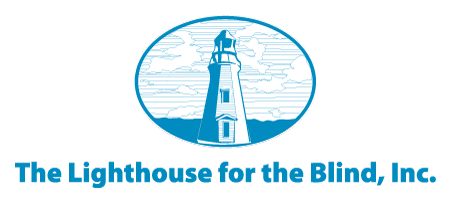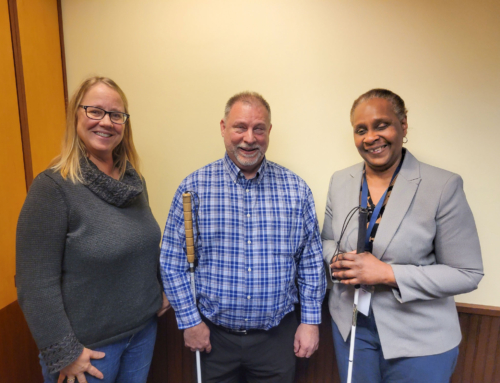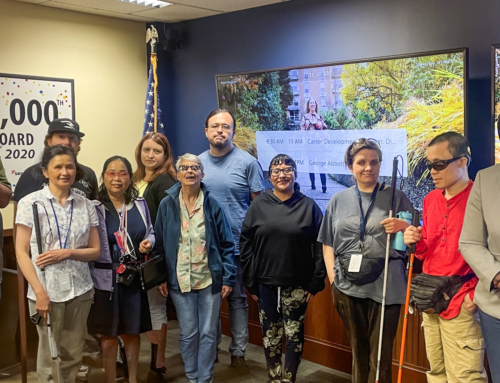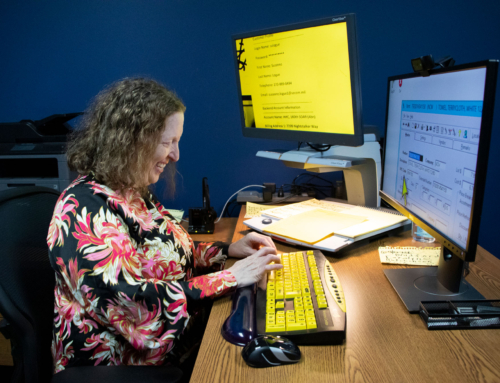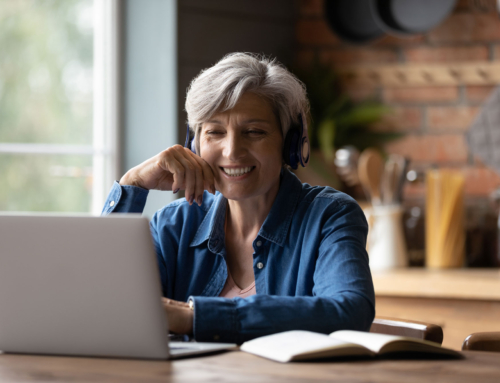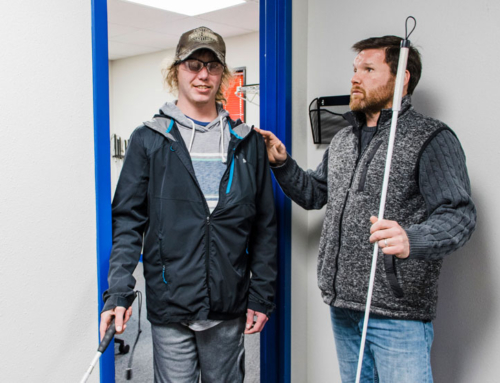What is Orientation & Mobility?
One of the many services the Lighthouse offers to employees is Orientation & Mobility (O&M) training. “O&M refers to the fine art of traveling while blind,” Erin Fitzpatrick, Supervisor of Orientation & Mobility Services at the Lighthouse explains. “Orientation is about where things are, where you are, where you are in relation to those things, and where those things are in relation to each other. Mobility is about actually getting through all of that safely.”
The O&M program at the Lighthouse serves more than 250 people yearly, with nearly 2,000 hours of training. O&M training at the Lighthouse covers white cane training (learn more about white cane training here). But the program also includes training on bus travel, route planning, assistive technology assessment, and safety techniques for low-vision travelers. It even includes relocation and route planning for new community members, and supplemental training for guide-dog users.
“We offer services at all of our locations,” Erin explains. “In the places we do not have staff, we contract with local O&Ms.”
How the O&M Program at the Lighthouse Stands Out
“One of the really unique and important things about what we do here is that we provide services directly to our employees really before anything else. That means when somebody starts at the Lighthouse, they get immediate services,” Tim Paulding, ECS Services & Instructional Manager at the Lighthouse notes. “Your first day on the job an O&M instructor will assess you, learn about your basic O&M needs, work with you to develop some goals, and together, figure out the best way to get you from work to home and home to work.”
Tim continues, “Right now, and for a long time, there’s been a shortage of specialized blindness skills instructors. There’s a long waiting list in many state and federally funded programs and often people have to wait months for services.”
“Other programs, state and federal programs, they’re underfunded. They’re understaffed. That’s one of the reasons I got into this field, being able to teach someone. Not only that, but to empower them to become more independent in their lives.”
Getting Started With O&M
Orientation & mobility needs vary widely for each individual! Employees at the Lighthouse are various ages and come from a variety of backgrounds. Employees also have a variety of different eye conditions and levels of visual impairment. As Tim notes, “some people have had tons of O&M training since they were in high school, middle school, or even when they were children. Other folks have had no O&M training. The Lighthouse might be the first encounter they’ve ever had with blindness services of any kind. It’s really cool to work here because I get to work with a variety of people.”
For those learning orientation and mobility skills for the first time, the technical skills aren’t the only thing they have to master. Tim shares, “when someone is adjusting to blindness, it can be really intense. There are a lot of fears that they have to face when crossing a street for the first time. Facing those fears, getting out there, and actually doing it causes a lot of feelings. Oftentimes, when I’m traveling a route with somebody, I get to talk to them about independence. I get to encourage them and that is a huge part of the job.”
“I am a blind instructor. So, I think that aspect of my job is even more apparent because I can be an example and a role model to them. There aren’t very many blind O&M instructors.”
Learning How to Use a White Cane
Beginning O&M training starts with learning to use a mobility device called a white cane. Once that is mastered, other skills are added on top of that. Tim explains, “we start out with the basics of using the white cane. The next step is learning how to cross simple intersections. Then we move on to high level things like finding directions to a place that they would like to go. Then we move on to stuff that I think is a real privilege to teach, which is combining technology with some of the safe travel skill that I teach.”
Those that are already skilled white cane users, still have the opportunity to utilize orientation and mobility services. “Once you get settled and acclimated, there may be something else that comes up. You move, or you’d really like to start shopping at a different grocery store, or there’s construction near your house.
Erin continues, “we work on other goals. Maybe you’ve found this new challenging intersection that you would like to cross, we can work with you on that to make sure you have the skills to do it safely. Maybe you want to learn how to get to your doctor’s office, or just a route out in your community and that’s when we could work on that.”
How You Can Get Involved
Our acclaimed Employee and Community Services program offers a wide range of services and resources for people in the blindness community. Programs like Orientation & Mobility help individuals adapt to their vision loss and foster feelings of empowerment.
The Orientation and Mobility Program is funded through a combination of community support and grants from organizations. Financial contributions from local corporations, foundations, service organizations and individuals are essential for this program. Make a gift to our ECS program today, and support someone navigating their own vision loss journey.
Your gift to the Lighthouse for the Blind, Inc. supports people who are blind, DeafBlind, or blind with other disabilities as they pursue independence and empowerment through meaningful, sustainable, and diverse employment opportunities.
